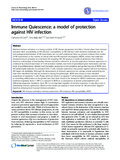| dc.description.abstract | Abstract
Aberrant immune activation is a strong correlate of HIV disease progression, but little is known about how immune activation alters susceptibility to HIV infection. Susceptibility to HIV infection varies between individuals, but the immunological determinants of HIV transmission are not well understood. Here, we present evidence from studies of HIV transmission in the context of clinical trials and HIV-exposed seronegative (HESN) cohorts that implicates elevated immune activation as a risk factor for acquiring HIV. We propose a model of protection from infection based on a phenotype of low baseline immune activation referred to as immune quiescence. Immune quiescence is evidenced by reduced expression of T cell activation markers, low levels of generalized gene transcription and low levels of proinflammatory cytokine and chemokine production in the periphery and genital mucosa of HESN. Since HIV preferentially replicates in activated CD4+ T cells, immune quiescence may protect against infection by limiting HIV target cell availability. Although the determinants of immune quiescence are unclear, several potential factors have been identified that may be involved in driving this phenotype. HESN were shown to have elevated proportions of regulatory T cells (Tregs), which are known to suppress T cell activation. Likewise, proteins involved in controlling inflammation in the genital tract have been found to be elevated in HESN. Furthermore, expression of interferon regulatory factor 1 (IRF-1) is reduced in HESN as a consequence of genetic polymorphisms and differential epigenetic regulation. Since IRF-1 is an important regulator of immune responses, it may play a role in maintaining immune quiescence. Based on this model, we propose a novel avenue for HIV prevention targeted based on reducing host mucosal immune activation. | |


